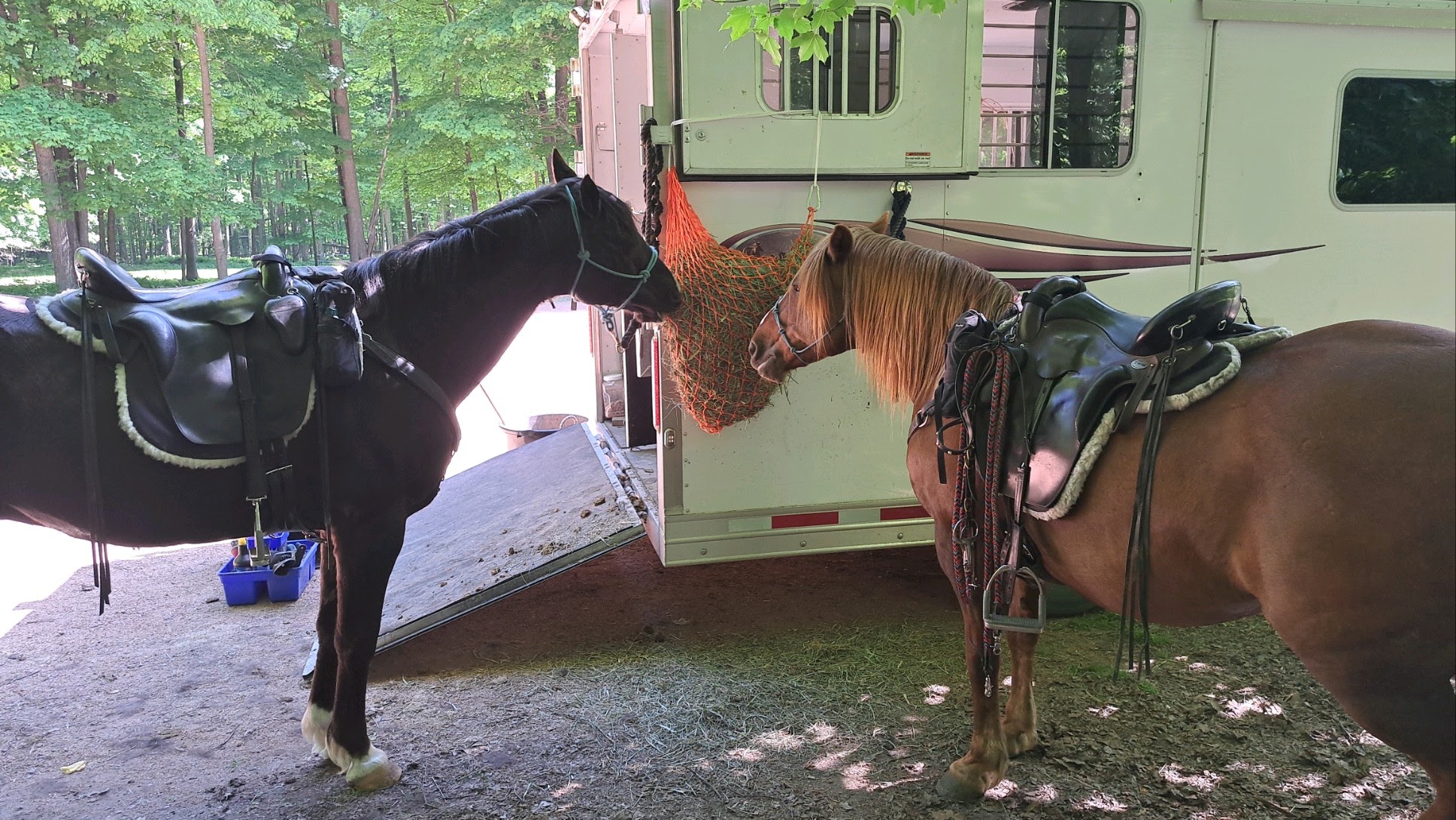
Leading up to the race weekend, we undertook a final dress rehearsal to ensure we were fully prepared for the big day’s momentum and the challenges it might bring. Our preparations included assembling at the scenic Big Eau Plaine County Park, undergoing check-ins, vetting procedures, trotting out, and embarking on our initial loop.
Upon returning to the trailhead, we completed check-ins, conducted necessary pulse assessments, untacked our horses, and participated in a mock vet check and trot out. This mid-way point also marked the determination of our ‘out time,’ which signifies when we’re eligible to embark on the second loop.
During our final trailhead check-in, we pulsed down, untacked, and completed our last vet check. A notable activity of the day was introducing our horses to a horse and cart. Interestingly, none of our horses exhibited any apprehension towards the cart, whether it was stationary or moving around the parking area in various directions.
Understanding horse-cart interactions is crucial during races, where encounters with carts are possible. It’s valuable to discern whether it’s safe to remain mounted or if dismounting is advisable. Surprisingly, many horses will trail a cart, though direct head-on or passing interactions can be unnerving for them.
Race Weekend and Event Overview
Thursday
The Louise Reidel Memorial Endurance Race weekend spanned Friday, Saturday, and Sunday. Arriving on Thursday, we provided our horses time to acclimate to the surroundings and established our camp. Opting to arrive ahead of our Saturday 25LD ride allowed for a smoother transition into the event.
With our mentor participating on Friday, we attended the initial ride meeting on Thursday evening. These meetings are vital, offering insights into the designated trails and their conditions for the event.
Endurance endeavors often involve volunteering. Sandy and I were designated as scribes for the vets on Friday, an unfamiliar task. Scheduled to begin at 8 am, we wrapped up the day’s activities and rested in our camp for the evening.
Friday – Volunteering
Friday morning commenced with our preparedness for the day’s events. At 8 am, we reported for our scribe duties. Most riders were already on their initial loops, slated to return starting around 8:30 am. Endurance rides, whether 100, 50, or 25 miles, along with Competitive Trail 25s, typically set out between 6 am and 7 am. The first loop, covering 15 miles, was succeeded by a 12-mile second loop. This total of 27 miles taught me that not all races conform to standard distances, a valuable lesson for the future.
As riders returned, our interaction with the vets became more streamlined. We gained insight into their evaluation criteria, which proved immensely educational. Horse care stands at the core of endurance, with horses expected to be in prime condition to undertake another loop after the ride.
Takeaways and Experiences
If there is one thing that Endurance is all about, it is the care of the horse. Ensuring that they are in excellent shape to continue. As the idea is that when you have completed your ride, that your horse would be able to go out and ride one more loop. Not that they should or that you would even want to afterwards, but a well conditioned and cared for horse throughout the race should still be metabolically able to set out again.
I watched a rider pull her horse due to cramping, which I learned is due to a lack of calcium and potassium. Later, I also saw that horse improve after the correct treatment was applied. I also witnessed a horse come in with one of those magical heart rates of 28bpm after pulsing down. Some of that was the fact that the horse was an Arab but it is also a testament of how that rider cared for her horse.
Once we were done with our scribing duties, we headed back to camp to take the girls out for a short ride. See where their heads were at. I discovered that my horse has a touch of ‘race-brain’ which is something that I suspected she would have and was hoping that this little outing would help with that.




Race Day and Insights
Race day brought both anticipation and challenges. The early wake-up call of 4:30 am was marked by restless sleep due to nerves and discomfort. However, we were ready for our 6:45 am ride start time. After tending to the horses and ourselves, we set out with our essentials prepared in the crew area.
Tack preparation, stowing water bottles, and readying for departure were the next steps. Our crew area was meticulously arranged the previous night, complete with mash, hay, electrolytes, water buckets, and shower supplies.
The First Loop: Energetic Beginnings
Our preparations complete, we eagerly mounted up and headed towards the starting timer, ready to embark on our ride. Anticipating a more spirited ride than usual, we were met with just that. Although we managed a calm exit from the campground, the moment the trail beckoned, we succumbed to an exhilarating pace. This speed, though exhilarating, proved difficult to moderate, even as I recognized its unsustainability.
For the initial 6 miles, we maintained this swift tempo, punctuated only by intermittent walking periods. These bursts of speed exhausted Gracie quicker than I deemed prudent. Faced with a choice, I had to decide between resisting my horse’s energy and depleting our resources, or persuading her to decelerate and find a state of calm.
Strategic Decisions: Managing the Ride
Upon completing the first 15-mile loop, our priority was to return pulsed down. Given the challenge of sustaining a steady walk, we chose to dismount and loosen our girths, opting to hand walk the final portion. Although our timing was slightly off, causing us to walk closer to 3 miles, we reached camp to check in.
At our crew area, we untacked and readied ourselves for the pulse check and vet examination. Cooling off our horses, washing them down, and allowing them to consume their mash provided a brief respite. The humans, however, found no rest during this brief interval – it was the swiftest 10 minutes ever experienced.
Following our successful vet check, a 50-minute countdown commenced, with our out time set for 10:30. We returned to the trailer, briefly resting for what felt like a mere 30 seconds before resuming preparations for the second 12-mile loop.
The Second Loop: A More Relaxed Ride
Heading towards the gate for the second loop, our horses displayed less exuberance, hinting at a touch of incredulity towards our endeavor. However, obediently they set forth, albeit at a significantly gentler pace. As we warmed up, we gradually increased our pace, aiming to meet the 12:45pm deadline, which marked the end of the 6-hour endurance ride. Commencing at 6:45am, our goal was to return by 12:45pm.
In this slower-paced loop, we managed to encourage our horses to eat and drink along the trail. Pausing at watering tanks, we allowed our equine companions to cool down and refreshed their faces. During one stretch, a stirrup leather unexpectedly snapped, causing my stirrup iron to drop. Fortunately, I adeptly repositioned it on different holes, allowing me to complete the final 6 miles.
Finding Comfort in Some Lessons Learned
As time ticked away, it became apparent that reaching camp by 12:45pm was unlikely. While we could have pushed our horses to the brink, we chose a more compassionate approach. Opting to ensure their well-being and arriving slightly behind schedule, we embraced this as a valuable learning opportunity.
Once we decided to focus on our own ride, letting go of time pressure, a sense of relief washed over us. As we returned, our horses cooled down and their pulses settled, we acknowledged that we might not have secured a completion, but we had successfully completed the ride. At the crew area, additional crew members provided support, guiding us through the final vet check and offering a comprehensive view of our ride.
The last vet check proved successful, underscoring our diligent care of the horses, despite our delayed arrival.
Valuable Insights from Endurance Riding: Lessons Learned
From this one experience I took away so much I hope I don’t forget anything.
Ride Your Own Ride
Understanding the significance of this phrase truly dawned on me when our group intermingled with another. The dynamics of riding alongside others can be unexpectedly challenging, affecting both you and your horse. Personally, I grew to prefer a more solitary ride.
Midway Moments: Faster Than Time
Amid the race, the midway point materializes as a whirlwind of minutes. Under normal circumstances, it might feel like ample time, but on race day, it rushes by like a fleeting breeze.
Prepare for the Unexpected: Extra Leathers
A simple yet vital lesson: always carry an additional set of leathers. Tack malfunctions can occur without warning. I was fortunate that my leathers held up after adjustment, allowing me to ride back safely.
Practice Makes Perfect: Conditioning Rides
Enhance your horse’s adaptability by practicing double or even triple loops on conditioning rides. They do not need to be long loops. Returning, untacking, resting, then venturing out again conditions your horse for the unpredictability of subsequent loops.
Mastery of Gaits: Speed and Control
Achieve mastery over your horse’s speed and gait duration. This doesn’t imply constant restraint; rather, it means maintaining precise control over the requested pace. Such mastery proves invaluable, especially on the high-speed initial loop.
Prioritize Metabolic Care
Understanding the nuances of metabolic care is crucial. Ignorance led to cramping issues with my horse, Gracie, hours after we concluded our ride. Learning about calcium’s role came a bit late but will influence future preparations.
Navigating Variable Distances
Be aware of distance variability in races. For instance, a 25LD race spanning 27 miles demands a slightly higher average speed. Monitoring speed and time with a helpful app ensures a steady pace.
The Power of Volunteering
Volunteering at rides isn’t just about lending a hand; it’s about gaining invaluable insights. The friendships formed and knowledge gained from these experiences are indispensable. The endurance community’s willingness to assist newcomers is commendable.
Guidance from a Mentor
Seek mentorship for personalized guidance. A good mentor provides not only information but also encourages independent research. Avoid information overload from online groups by focusing on mentor-led learning. I found mine at the Fox Valley Distance Equestrian Team
Preparation and Care: The Ride Takes Care of Itself
Thorough preparation ensures a smoother ride experience. When you’ve prepared well, the ride itself becomes more manageable, allowing you to concentrate on the journey.
Success Beyond Breed: Best Condition Award
Triumph in endurance riding doesn’t hinge on having an Arabian horse. The coveted Best Condition award centers on diligent horse care and meticulous preparation, regardless of breed.
Balancing Fitness: Rider and Horse
Acknowledge the importance of rider fitness alongside horse fitness. Horses naturally maintain fitness better, but humans must consistently exercise. Walking or exercising with your horse not only improves fitness but also nurtures a unique bond.
Solo Riding Mastery
While riding with companions is delightful, it may not optimize performance on race day unless horses are well-matched. Developing solo riding skills is paramount. Mastering confident, independent riding at any speed is vital for event success.
Harnessing Solo Riding Skills
Learning to ride alone is a significant endeavor. Despite the appeal of group rides, mastering solo riding is crucial. This is an endeavor Gracie and I are embarking on, honing our skills and independence for the trail.
Seizing Ride Meeting Insights
Attending the pre-ride meeting is invaluable. It offers essential information that will prove beneficial during your ride, contributing to a well-informed and successful experience.





